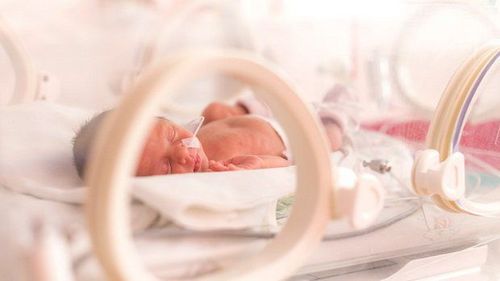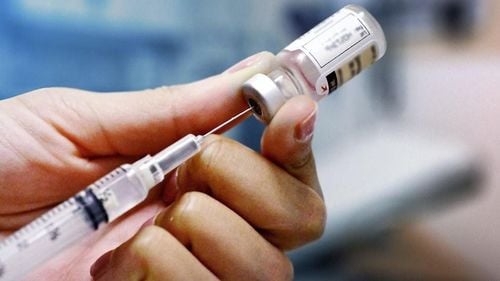This is an automatically translated article.
Placing a long line to the central vein from the periphery helps to nourish the veins in newborns, especially premature babies, as well as to treat venous diseases of relatively small children. This method is mainly used in emergency resuscitation.
1. What is the technique of placing a central venous line from the periphery?
Peripheral central venous catheterization (abbreviation: PICC) is the setting up of a catheter from a peripheral vein at the elbow and threading the end of the tube to a central vein. This technique is now widely practiced in the critical care and surgical departments of large hospitals by trained nurses and doctors.
After establishing a central venous line from the periphery to nourish the vein, there is usually some bleeding or bruising at the catheter site. Your child's arm may feel a little sore for about 1-2 days. This line will be kept in place until the child has been treated. During setup, the child may need to be anesthetized to place a central venous line from the periphery.
2. Indication for implementation
Establishment of a central venous line from the periphery of the PICC for parenteral nutrition in the neonate is indicated in cases where it is necessary:
Intravenous feeding of the neonate and premature birth. Reduce the number of times your child is stabbed with a needle. Infusion of drugs and fluids from the infant's relatively small vein into a larger vein. Take most types of blood samples for testing. Note contraindications to central venous access from the periphery in the condition that the child has bruises, edema, or infection at the injection site.

3. Parts of central venous line from periphery
A complete peripheral central venous line consisting of the following:
Flexible tube: Located inside a catheter, which is inserted into a large vein to lead to the heart; Outlet Catheter: In a position on the child's arm, located outside the body, there may be one or two tubes; Specialized bandage: Has the shape of a disc and is located on the site of the tube to prevent bacteria from entering the body; Medical bandage: Clear plastic, placed on the catheter, to help limit infection and keep the catheter in place; A cap: A place to inject drugs and fluids, the catheter can also be extended;
4. Preparation Process
The preparation process for pediatric patients includes 8 steps:
Step 1: The doctor will explain to relatives about the technique to be performed; Step 2: Correction of severe coagulopathy before injection to avoid bleeding complications at the injection site (only test for children with clinical signs of bleeding); Step 3. Use sedatives and pain relievers with the aim of limiting stimulation for pediatric patients; Step 4. Measure and estimate the length of the catheter in the vein; Step 5. Healthcare workers wash their hands and wear personal protective equipment to ensure sterility; Step 6. Open the central catheterization kit; Step 7. Use povidine to disinfect the wide area of the elbow; Step 8. Ultrasound identifies the vein, the diameter and depth of the vein as well as the direction of the needle;
5. Implementation process
Carry out the method of setting up the PICC with the following steps:
Step 1: Inject the basilar vein at the elbow with a needle; Step 2: Thread the wire into the threading needle; Step 3: Incision and dilatation of the skin; Steps 4, 5, 6: Insert catheters, wires, needles and necessary tools into the vein; Step 7: Check the length of the catheter in the vein; Step 8: Sew the skin and fix the catheter; Step 9: Check the position of the catheter tip; Step 10: Medical staff remove personal protective clothing and wash hands; Step 11: Record detailed implementation records.
6. Complications and treatment directions
Establishing a central venous line from the periphery to nourish the veins is a complicated technique, even when performed by qualified medical personnel, there are cases of complications such as:
Embolism due to thrombosis; Infection; Injecting the wrong artery; Cardiac arrhythmias; Bleeding at the injection site. Following the catheterization procedure, ensuring sterility, and checking the passages regularly is the best way to prevent complications. Depending on each sign, the doctor will consider and prescribe the treatment direction, such as treating thrombosis, blood clotting disorder, using antibiotics or shortening the lead and catheter for the child.
7. Follow-up and care

Intravenous feeding of neonates, premature infants and even older children need to be closely monitored. Post-catheterization requires a trained medical staff to care for the baby carefully. Specifically:
Change of cap and bandage must be carried out at least weekly; The catheter must be cleaned with heparin anticoagulant daily and after each use; Keep the medical dressings and skin of the patient clean and dry to prevent bacteria and pathogens from entering the bloodstream through the catheter; If the special dressing becomes wet or comes off, the replacement procedure must be sterile and performed by trained professionals; Baby's arms should be kept dry at all times, completely covered with waterproof wrap if they have to bathe or wash; Periodically check the catheter for signs of cracking or damage;
8. Note for older children
In older children receiving treatment and parenteral nutrition, if the PICC line is placed for a long time, they can still be discharged during that time and return to normal activities. However, it is necessary to pay close attention to the instructions of the doctor to protect the child's safety. Parents need to keep the following notes in mind:
Inform teachers and school staff about the child's condition; Children are not allowed to play hard, avoid collisions and contact with water; Always carry caps, clamps and line setup materials with you; Ensure the sterility of the tools, do not use when dropped on the ground or accidentally touched by someone, or expired, the wrapper is not intact; If the baby has to go to any clinic or emergency room, the doctors and nurses there must be informed from the start that the baby is having a central venous line from the periphery, which is extremely important. important.
The method of placing a central venous catheter from a peripheral vein to provide parenteral nutrition in neonates, premature infants and even older children when they cannot satisfy their nutritional needs through oral or nasogastric tubes. . In addition, setting up PICC also supports the treatment of some diseases related to veins in pediatric patients. This is a rather complicated technique, requiring the implementation of a team of highly qualified and experienced doctors at large and prestigious hospitals.
As a key area of Vinmec Health system, Pediatrics Department always brings satisfaction to customers and is highly appreciated by industry experts with:
Gathering a team of top doctors and nurses in Pediatrics : consists of leading experts with high professional qualifications (professors, associate professors, doctorates, masters), experienced, worked at major hospitals such as Bach Mai, 108.. Doctors All doctors are well-trained, professional, conscientious, knowledgeable about young psychology. In addition to domestic pediatric specialists, the Department of Pediatrics also has the participation of foreign experts (Japan, Singapore, Australia, USA) who are always pioneers in applying the latest and most effective treatment regimens. . Comprehensive services: In the field of Pediatrics, Vinmec provides a series of continuous medical examination and treatment services from Newborn to Pediatric and Vaccine,... according to international standards to help parents take care of their baby's health from birth to childhood. from birth to adulthood Specialized techniques: Vinmec has successfully deployed many specialized techniques to make the treatment of difficult diseases in Pediatrics more effective: neurosurgery - skull surgery, stem cell transplantation. blood in cancer treatment. Professional care: In addition to understanding children's psychology, Vinmec also pays special attention to the children's play space, helping them to have fun and get used to the hospital's environment, cooperate in treatment, improve the efficiency of medical treatment.
Please dial HOTLINE for more information or register for an appointment HERE. Download MyVinmec app to make appointments faster and to manage your bookings easily.













